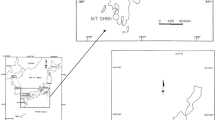Abstract
The geometric and spatial characteristics of pore structures determine the permeability and water retention of soils, which have important effects on soil functional diversity and ecological restoration. Until recently, there have not been tools and methods to visually and quantitatively describe the characteristics of soil pores. To solve this problem, this research reconstructs the geometry and spatial distribution of soil pores by the marching cubes method, texture mapping method and the ray casting method widely used in literature. The objectives were to explore an optimal method for three-dimensional visualization of soil pore structure by comparing the robustness of the three methods on soil CT images with single pore structure and porosity ranging from low (2–5%) to high (12–18%), and to evaluate the reconstruction performance of the three methods with different geometric features. The results demonstrate that there are aliases (jagged edges) and deficiency at the boundaries of the model reconstructed by the marching cubes method and pore volumes are smaller than the ground truth, whereas the results of the texture mapping method lack the details of pore structures. For all the soil images, the ray casting method is preferable since it better preserves the pore characteristics of the ground truth. Furthermore, the ray casting method produced the best soil pore model with higher rendering speed and lower memory consumption. Therefore, the ray casting method provides a more advanced method for visualization of pore structures and provides an optional technique for the study of the transport of moisture and the exchange of air in soil.







Similar content being viewed by others
References
Bozorgi M, Lindseth F (2015) GPU-based multi-volume ray casting within VTK for medical applications. Int J Comput Assist Radiol Surg 10(3):293–300
Elliot TR, Heck RJ (2007) A comparison of optical and X-ray CT technique for void analysis in soil thin section. Geoderma 141(1–2):60–70
Falconer RE, Houston AN, Otten W, Baveye PC (2012) Emergent behavior of soil fungal dynamics: influence of soil architecture and water distribution. Soil Sci 177(2):111–119
Hill RL, Horton R, Cruse RM (1985) Tillage effects on soil water retention and pore size distribution of two mollisols 1. Soil Sci Soc Am J 49(5):1264–1270
Hwang H, Haddad RA (1995) Adaptive median filters: new methods and results. IEEE Trans Image Process 4(4):499–502
Kopf JP, Hedman LPJ, Szeliski R (2018) Three-dimensional scene reconstruction from set of two dimensional images for consumption in virtual reality. United States Patent Application No. 10/038,894
Krinidis S, Chatzis V (2010) A robust fuzzy local information C-means clustering method. IEEE Trans Image Process 19(5):1328–1337
Levoy M (1988) Display of surfaces from volume data. IEEE Comput Graph Appl 1(3):29–30
Li W, Gong H, Yang R (2018) Fast texture mapping adjustment via local/global optimization. IEEE Trans Vis Comput Graph. https://doi.org/10.1109/tvcg.2018.2831220
Max N (1995) Optical models for direct volume rendering. IEEE Trans Vis Comput Graph 1(2):99–108
Munkholm LJ, Heck RJ, Deen B (2012) Soil pore characteristics assessed from X-ray micro-CT derived images and correlations to soil friability. Geoderma 181:22–29
Nielson GB, Hamann B (1991) The asymptotic decider: resolving the ambiguity in marching cubes. In: Proceedings of the 2nd conference on visualization. https://doi.org/10.1109/visual.1991.175782
Ray H, Pfister H, Silver D, Cook TA (1999) Ray casting architectures for volume visualization. IEEE Trans Vis Comput Graph 5(3):210–223
Shi Z, Jinyi C (2015) Improved method of volume rendering combined texture mapping with ray casting based on CUDA. Appl Res Comput 32(06):1884–1887
Taina IA, Heck RJ, Elliot TR (2008) Application of X-ray computed tomography to soil science: a literature review. Can J Soil Sci 88(1):1–20
Thanh CQ, Hai NT (2017) Trilinear interpolation method for reconstruction of 3D MRI brain image. Am J Signal Process 7(1):1–11
Yu X, Fu Y, Lu S (2017) Characterization of the pore structure and cementing substances of soil aggregates by a combination of synchrotron radiation X-ray micro-computed tomography and scanning electron microscopy. Eur J Soil Sci 68(1):66–79
Zelelew HM, Almuntashri A, Agaian S, Papagiannakis AT (2013) An improved image processing technique for asphalt concrete X-ray CT images. Road Mater Pavement Des 14(2):341–359
Zhang W, Xu C, Liu J (2018) Image processing method and apparatus for three-dimensional reconstruction. U.S. Patent Application No. 10/043,308
Zhao Y, Han QL, Zhao YD, Liu JH (2018) Soil pore identification with the adaptive fuzzy C-means method based on computed tomography images. J For Res 20:50–60. https://doi.org/10.1007/s11676-018-0725-3
Author information
Authors and Affiliations
Corresponding author
Additional information
Project Funding: This work was supported by the National Natural Science Foundation Project (41501283), Beijing Science and Technology Plan Project (Z161100000916012), the National Key Research and Development Program (2017YFD0600901), Special Fund for Beijing Common Construction Project, and the Fundamental Research Funds for the Central Universities (2015ZCQ-GX-04).
The online version is available at http://www.springerlink.com.
Corresponding editor: Chai Ruihai.
Rights and permissions
About this article
Cite this article
Han, Q., Zhou, X., Liu, L. et al. Three-dimensional visualization of soil pore structure using computed tomography. J. For. Res. 30, 1053–1061 (2019). https://doi.org/10.1007/s11676-018-0834-z
Received:
Accepted:
Published:
Issue Date:
DOI: https://doi.org/10.1007/s11676-018-0834-z




